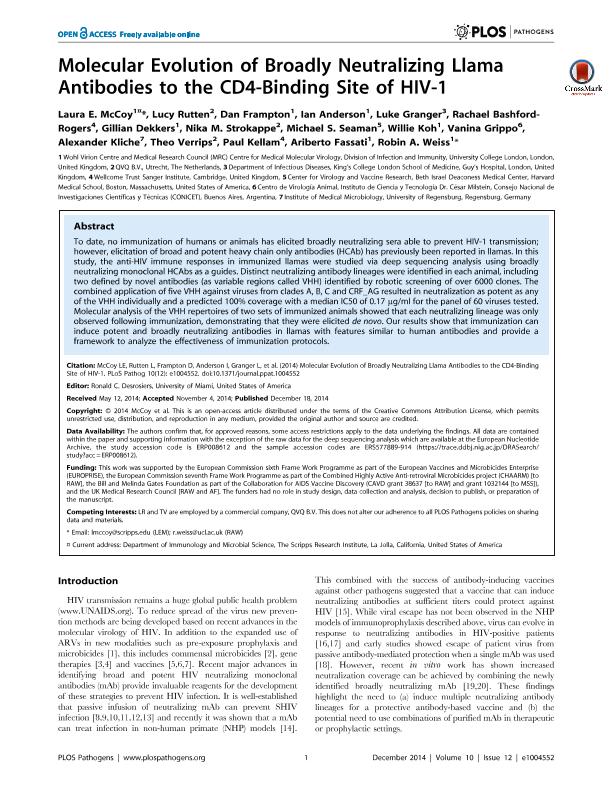Mostrar el registro sencillo del ítem
dc.contributor.author
McCoy, Laura E.
dc.contributor.author
Rutten, Lucy
dc.contributor.author
Frampton, Dan
dc.contributor.author
Anderson, Ian
dc.contributor.author
Granger, Luke
dc.contributor.author
Bashford Rogers, Rachael
dc.contributor.author
Dekkers, Gillian
dc.contributor.author
Strokappe, Nika M.
dc.contributor.author
Seaman, Michael S.
dc.contributor.author
Koh, Willie
dc.contributor.author
Grippo, Vanina

dc.contributor.author
Kliche, Alexander
dc.contributor.author
Verrips, Theo
dc.contributor.author
Kellam, Paul
dc.contributor.author
Fassati, Ariberto
dc.contributor.author
Weiss, Robin A.
dc.date.available
2016-02-11T19:53:04Z
dc.date.issued
2014-12
dc.identifier.citation
McCoy, Laura E.; Rutten, Lucy; Frampton, Dan; Anderson, Ian; Granger, Luke; et al.; Molecular evolution of broadly neutralizing llama antibodies to the CD4-binding site of HIV-1; Public Library of Science; Plos Pathogens; 10; 12; 12-2014; e1004552-e1004552
dc.identifier.issn
1553-7366
dc.identifier.uri
http://hdl.handle.net/11336/4155
dc.description.abstract
To date, no immunization of humans or animals has elicited broadly neutralizing sera able to prevent HIV-1 transmission; however, elicitation of broad and potent heavy chain only antibodies (HCAb) has previously been reported in llamas. In this study, the anti-HIV immune responses in immunized llamas were studied via deep sequencing analysis using broadly neutralizing monoclonal HCAbs as a guides. Distinct neutralizing antibody lineages were identified in each animal, including two defined by novel antibodies (as variable regions called VHH) identified by robotic screening of over 6000 clones. The combined application of five VHH against viruses from clades A, B, C and CRF_AG resulted in neutralization as potent as any of the VHH individually and a predicted 100% coverage with a median IC50 of 0.17 µg/ml for the panel of 60 viruses tested. Molecular analysis of the VHH repertoires of two sets of immunized animals showed that each neutralizing lineage was only observed following immunization, demonstrating that they were elicited de novo. Our results show that immunization can induce potent and broadly neutralizing antibodies in llamas with features similar to human antibodies and provide a framework to analyze the effectiveness of immunization protocols.
dc.format
application/pdf
dc.language.iso
eng
dc.publisher
Public Library of Science

dc.rights
info:eu-repo/semantics/openAccess
dc.rights.uri
https://creativecommons.org/licenses/by/2.5/ar/
dc.subject
Neutralizing Llama Antibodies
dc.subject
Hiv-1
dc.subject
Cd4-Binding Site
dc.subject
Molecular Evolution
dc.subject.classification
Virología

dc.subject.classification
Ciencias Biológicas

dc.subject.classification
CIENCIAS NATURALES Y EXACTAS

dc.title
Molecular evolution of broadly neutralizing llama antibodies to the CD4-binding site of HIV-1
dc.type
info:eu-repo/semantics/article
dc.type
info:ar-repo/semantics/artículo
dc.type
info:eu-repo/semantics/publishedVersion
dc.date.updated
2016-03-30 10:35:44.97925-03
dc.journal.volume
10
dc.journal.number
12
dc.journal.pagination
e1004552-e1004552
dc.journal.pais
Estados Unidos

dc.journal.ciudad
San Francisco
dc.description.fil
Fil: McCoy, Laura E.. University College London. Division of Infection and Immunity. Centre for Medical Molecular Virology. Wohl Virion Centre and Medical Research Council; Reino Unido
dc.description.fil
Fil: Rutten, Lucy. QVQ B.V.; Países Bajos
dc.description.fil
Fil: Frampton, Dan. University College London. Division of Infection and Immunity. Centre for Medical Molecular Virology. Wohl Virion Centre and Medical Research Council; Reino Unido
dc.description.fil
Fil: Anderson, Ian. University College London. Division of Infection and Immunity. Centre for Medical Molecular Virology. Wohl Virion Centre and Medical Research Council; Reino Unido
dc.description.fil
Fil: Granger, Luke. King’s College London. School of Medicine. Guy’s Hospital. Department of Infectious Diseases; Reino Unido
dc.description.fil
Fil: Bashford Rogers, Rachael. Wellcome Trust Sanger Institute; Reino Unido
dc.description.fil
Fil: Dekkers, Gillian. University College London. Division of Infection and Immunity. Centre for Medical Molecular Virology. Wohl Virion Centre and Medical Research Council; Reino Unido
dc.description.fil
Fil: Strokappe, Nika M.. QVQ B.V.; Países Bajos
dc.description.fil
Fil: Seaman, Michael S.. Harvard Medical School. Beth Israel Deaconess Medical Center. Center for Virology and Vaccine Research; Estados Unidos
dc.description.fil
Fil: Koh, Willie. University College London. Division of Infection and Immunity. Centre for Medical Molecular Virology. Wohl Virion Centre and Medical Research Council; Reino Unido
dc.description.fil
Fil: Grippo, Vanina. Consejo Nacional de Investigaciones Científicas y Técnicas. Oficina de Coordinación Administrativa Parque Centenario. Instituto de Ciencias y Tecnología "Dr. Cesar Milstein"; Argentina
dc.description.fil
Fil: Kliche, Alexander. University of Regensburg. Institute of Medical Microbiology; Alemania
dc.description.fil
Fil: Verrips, Theo. QVQ B.V.; Países Bajos
dc.description.fil
Fil: Kellam, Paul. Wellcome Trust Sanger Institute; Reino Unido
dc.description.fil
Fil: Fassati, Ariberto. University College London. Division of Infection and Immunity. Centre for Medical Molecular Virology. Wohl Virion Centre and Medical Research Council; Reino Unido
dc.description.fil
Fil: Weiss, Robin A.. University College London. Division of Infection and Immunity. Centre for Medical Molecular Virology. Wohl Virion Centre and Medical Research Council; Reino Unido
dc.journal.title
Plos Pathogens

dc.relation.alternativeid
info:eu-repo/semantics/altIdentifier/url/http://journals.plos.org/plospathogens/article?id=10.1371/journal.ppat.1004552
dc.relation.alternativeid
info:eu-repo/semantics/altIdentifier/url/http://dx.doi.org/DOI:10.1371/journal.ppat.1004552
dc.relation.alternativeid
info:eu-repo/semantics/altIdentifier/issn/1553-7366
dc.relation.alternativeid
info:eu-repo/semantics/altIdentifier/url/http://www.ncbi.nlm.nih.gov/pubmed/25522326
Archivos asociados
